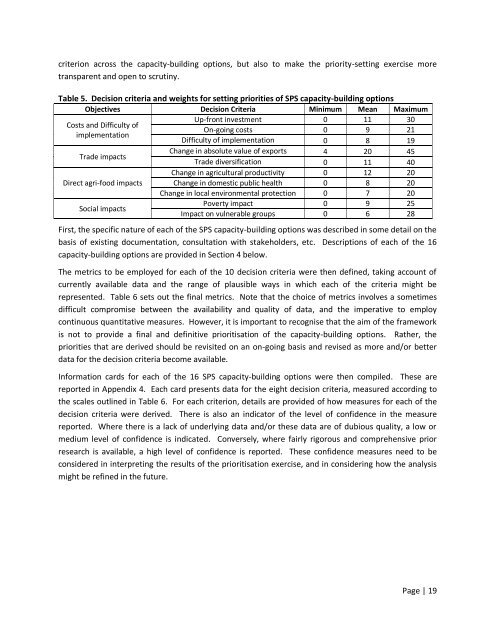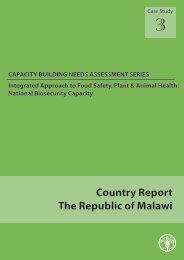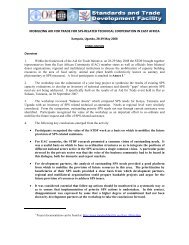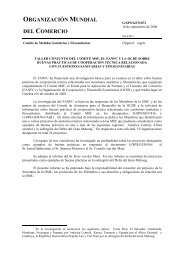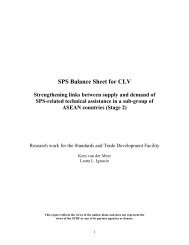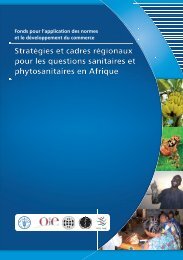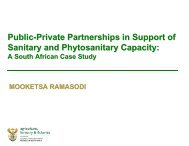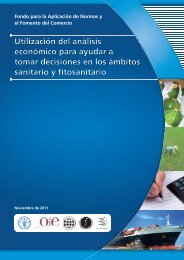MCDA Final Report Malawi - Standards and Trade Development ...
MCDA Final Report Malawi - Standards and Trade Development ...
MCDA Final Report Malawi - Standards and Trade Development ...
Create successful ePaper yourself
Turn your PDF publications into a flip-book with our unique Google optimized e-Paper software.
criterion across the capacity-building options, but also to make the priority-setting exercise more<br />
transparent <strong>and</strong> open to scrutiny.<br />
Table 5. Decision criteria <strong>and</strong> weights for setting priorities of SPS capacity-building options<br />
Objectives Decision Criteria Minimum Mean Maximum<br />
Up-front investment 0 11 30<br />
Costs <strong>and</strong> Difficulty of<br />
On-going costs 0 9 21<br />
implementation<br />
Difficulty of implementation 0 8 19<br />
<strong>Trade</strong> impacts<br />
Change in absolute value of exports 4 20 45<br />
<strong>Trade</strong> diversification 0 11 40<br />
Change in agricultural productivity 0 12 20<br />
Direct agri-food impacts Change in domestic public health 0 8 20<br />
Change in local environmental protection 0 7 20<br />
Social impacts<br />
Poverty impact 0 9 25<br />
Impact on vulnerable groups 0 6 28<br />
First, the specific nature of each of the SPS capacity-building options was described in some detail on the<br />
basis of existing documentation, consultation with stakeholders, etc. Descriptions of each of the 16<br />
capacity-building options are provided in Section 4 below.<br />
The metrics to be employed for each of the 10 decision criteria were then defined, taking account of<br />
currently available data <strong>and</strong> the range of plausible ways in which each of the criteria might be<br />
represented. Table 6 sets out the final metrics. Note that the choice of metrics involves a sometimes<br />
difficult compromise between the availability <strong>and</strong> quality of data, <strong>and</strong> the imperative to employ<br />
continuous quantitative measures. However, it is important to recognise that the aim of the framework<br />
is not to provide a final <strong>and</strong> definitive prioritisation of the capacity-building options. Rather, the<br />
priorities that are derived should be revisited on an on-going basis <strong>and</strong> revised as more <strong>and</strong>/or better<br />
data for the decision criteria become available.<br />
Information cards for each of the 16 SPS capacity-building options were then compiled. These are<br />
reported in Appendix 4. Each card presents data for the eight decision criteria, measured according to<br />
the scales outlined in Table 6. For each criterion, details are provided of how measures for each of the<br />
decision criteria were derived. There is also an indicator of the level of confidence in the measure<br />
reported. Where there is a lack of underlying data <strong>and</strong>/or these data are of dubious quality, a low or<br />
medium level of confidence is indicated. Conversely, where fairly rigorous <strong>and</strong> comprehensive prior<br />
research is available, a high level of confidence is reported. These confidence measures need to be<br />
considered in interpreting the results of the prioritisation exercise, <strong>and</strong> in considering how the analysis<br />
might be refined in the future.<br />
Page | 19


